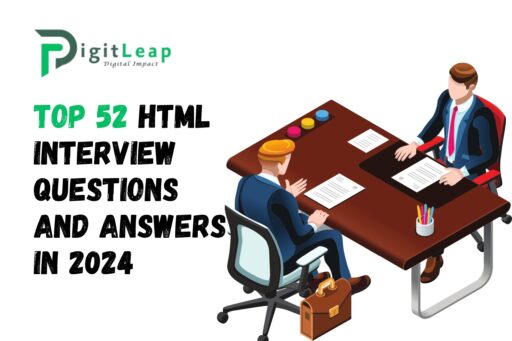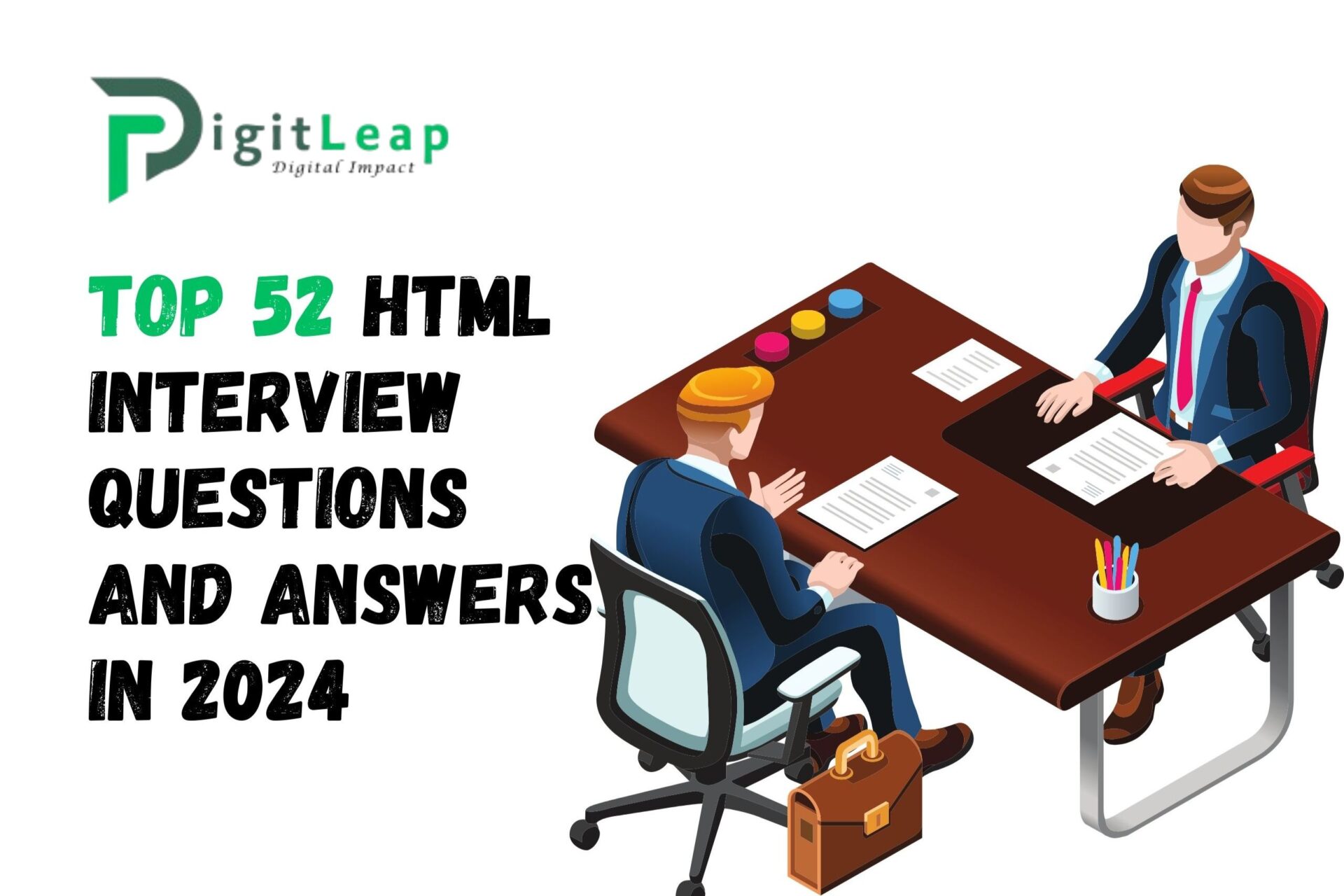Top 52 HTML Interview Questions and Answers in 2024
If you’re preparing for an HTML interview, whether you’re a fresher or have some experience, this list of 52 top HTML interview questions and answers will help you get ready. Each question is followed by a detailed answer, offering a comprehensive guide to understanding HTML better.
1. What is HTML?
Answer: HTML stands for HyperText Markup Language. It is the standard language used to create and design web pages. HTML uses a system of tags and attributes to structure content on the web.
2. What are HTML tags?
Answer: HTML tags are the building blocks of HTML. They are used to define elements on a web page. Tags are enclosed in angle brackets, for example, <p>, <a>, or <div>. Most tags come in pairs: an opening tag and a closing tag.
3. What is the purpose of the <head> tag in HTML?
Answer: The <head> tag contains meta-information about the HTML document, such as the title of the page, link to CSS stylesheets, and metadata. It is placed between the <html> and <body> tags.
4. What is the difference between <div> and <span> tags?
Answer: <div> is a block-level element used for grouping larger sections of content, while <span> is an inline element used for smaller portions of text or content within a block-level element.
5. How do you create a hyperlink in HTML?
Answer: To create a hyperlink, use the <a> tag. For example:
htmlCopy code<a href="https://www.example.com">Visit Example</a>
The href attribute specifies the URL of the page the link goes to.
6. What are attributes in HTML?
Answer: Attributes provide additional information about HTML elements. They are included within the opening tag and are written as name-value pairs, e.g., src="image.jpg" in an <img> tag.
7. What is the difference between an ID and a class in HTML?
Answer: An ID is a unique identifier for an element, meaning each ID should only be used once per page. A class, on the other hand, can be applied to multiple elements and is used for styling groups of elements.
8. How do you include a CSS file in an HTML document?
Answer: Use the <link> tag in the <head> section of your HTML document:
htmlCopy code<link rel="stylesheet" href="styles.css">
The href attribute specifies the path to the CSS file.
9. What is the purpose of the <meta> tag?
Answer: The <meta> tag provides metadata about the HTML document, such as character encoding, author, and description. It helps browsers and search engines understand the content of the page.
10. How do you insert an image in HTML?
Answer: Use the <img> tag, specifying the image source with the src attribute:
htmlCopy code<img src="image.jpg" alt="Description of image">
The alt attribute provides alternative text for the image.
11. What are semantic HTML elements?
Answer: Semantic HTML elements clearly describe their meaning in a human- and machine-readable way. Examples include <header>, <footer>, <article>, and <section>, which provide better structure and readability compared to generic tags like <div>.
12. How do you create a form in HTML?
Answer: Use the <form> tag to create a form. Include input elements such as <input>, <select>, and <textarea> for user data collection:
htmlCopy code<form action="/submit" method="post">
<label for="name">Name:</label>
<input type="text" id="name" name="name">
<input type="submit" value="Submit">
</form>
13. What is the <table> tag used for?
Answer: The <table> tag is used to create tables in HTML. It works with other tags like <tr> for rows, <th> for header cells, and <td> for data cells to structure tabular data.
14. How do you make a list in HTML?
Answer: Use the <ul> tag for an unordered list (bulleted) and the <ol> tag for an ordered list (numbered). List items are defined with the <li> tag:
htmlCopy code<ul>
<li>Item 1</li>
<li>Item 2</li>
</ul>
15. What is the difference between the <b> and <strong> tags?
Answer: <b> makes text bold without implying any importance, while <strong> indicates that the text is of strong importance and is typically displayed in bold.
16. What does the alt attribute do in an <img> tag?
Answer: The alt attribute provides alternative text for an image if the image fails to load or for users with visual impairments using screen readers.
17. How do you create a checkbox in HTML?
Answer: Use the <input> tag with the type attribute set to checkbox:
htmlCopy code<input type="checkbox" id="accept" name="accept" value="yes">
<label for="accept">I accept the terms and conditions</label>
18. What is the <iframe> tag used for?
Answer: The <iframe> tag is used to embed another HTML document within the current document. It creates an inline frame.
19. What is the difference between <strong> and <em> tags?
Answer: <strong> indicates that the text is of strong importance, typically displayed in bold. <em> indicates emphasized text, typically displayed in italics.
20. How do you create a dropdown menu in HTML?
Answer: Use the <select> tag with <option> elements to create a dropdown menu:
htmlCopy code<select name="options">
<option value="option1">Option 1</option>
<option value="option2">Option 2</option>
</select>
21. What is the purpose of the <link> tag?
Answer: The <link> tag is used to link external resources, such as stylesheets, to the HTML document. It is placed in the <head> section.
22. How do you add comments in HTML?
Answer: Comments are added using the <!-- and --> syntax:
htmlCopy code<!-- This is a comment -->
23. What is the <script> tag used for?
Answer: The <script> tag is used to include JavaScript in an HTML document. It can be placed in the <head> or <body> section.
24. What is the purpose of the <!DOCTYPE html> declaration?
Answer: The <!DOCTYPE html> declaration defines the document type and version of HTML being used. It ensures that the browser renders the page in standards mode.
25. How do you create a button in HTML?
Answer: Use the <button> tag to create a clickable button:
htmlCopy code<button type="button">Click Me</button>
26. What is the <meta charset="UTF-8"> tag used for?
Answer: The <meta charset="UTF-8"> tag specifies the character encoding for the HTML document, ensuring that characters are displayed correctly.
27. What is the difference between <input type="text"> and <textarea>?
Answer: <input type="text"> creates a single-line text input field, while <textarea> creates a multi-line text input field.
28. What is the role of the <footer> tag?
Answer: The <footer> tag is used to define the footer section of a document or section, often containing metadata, copyright information, or links.
29. How do you add a background color to an element?
Answer: You can add a background color using the style attribute or CSS:
htmlCopy code<div style="background-color: yellow;">This is a background color</div>
30. What is the <header> tag used for?
Answer: The <header> tag defines the header section of a document or section, often containing headings, navigation links, or introductory content.
31. How do you make a text link open in a new tab?
Answer: Use the target attribute with the value _blank in the <a> tag:
htmlCopy code<a href="https://www.example.com" target="_blank">Open Example in a new tab</a>
32. What is the <nav> tag used for?
Answer: The <nav> tag defines a navigation section of the document, typically containing links to other pages or sections of the site.
33. How do you create a radio button in HTML?
Answer: Use the <input> tag with the type attribute set to radio:
htmlCopy code<input type="radio" id="option1" name="options" value="1">
<label for="option1">Option 1</label>
34. What is the <article> tag used for?
Answer: The <article> tag represents a self-contained piece of content that can be distributed independently, such as a blog post or news article.
35. How do you create a table row in HTML?
Answer: Use the <tr> tag within a <table> to create a table row:
htmlCopy code<table>
<tr>
<td>Row 1, Cell 1</td>
<td>Row 1, Cell 2</td>
</tr>
</table>
36. What is the <aside> tag used for?
Answer: The <aside> tag defines content that is tangentially related to the content around it, such as a sidebar or a pull quote.
37. How do you make text italicized in HTML?
Answer: Use the <em> tag or the <i> tag to italicize text:
htmlCopy code<em>This text is italicized</em>
38. What is the <main> tag used for?
Answer: The <main> tag specifies the main content of the document, excluding headers, footers, and sidebars. It helps improve accessibility and SEO.
39. How do you include a video in HTML?
Answer: Use the <video> tag and specify the source file:
htmlCopy code<video width="320" height="240" controls>
<source src="movie.mp4" type="video/mp4">
Your browser does not support the video tag.
</video>
40. What is the role of the <form> tag?
Answer: The <form> tag is used to collect user input. It can include various input elements such as text fields, checkboxes, and submit buttons.
41. How do you create a tooltip in HTML?
Answer: Use the title attribute in an HTML element to create a tooltip:
htmlCopy code<p title="This is a tooltip">Hover over this text</p>
42. What is the <source> tag used for?
Answer: The <source> tag is used to specify multiple media resources for elements like <video> and <audio>, allowing the browser to select the best format.
43. How do you create a responsive layout in HTML?
Answer: Use CSS media queries and flexible grid layouts to create responsive designs that adjust to different screen sizes and devices.
44. What is the <figure> tag used for?
Answer: The <figure> tag is used to encapsulate media content, such as images, along with a <figcaption> for a caption.
45. How do you create a hyperlink to an email address?
Answer: Use the mailto: scheme in the href attribute of the <a> tag:
htmlCopy code<a href="mailto:example@example.com">Send Email</a>
46. What is the <label> tag used for in forms?
Answer: The <label> tag is used to define labels for form controls, improving accessibility and usability. It associates a text description with a form element using the for attribute.
47. How do you add comments in HTML?
Answer: Comments in HTML are written between <!-- and -->:
htmlCopy code<!-- This is a comment -->
48. What is the <meta name="viewport"> tag used for?
Answer: The <meta name="viewport"> tag is used to control the viewport’s size and scale on mobile browsers, ensuring that the layout is responsive.
49. How do you create a hidden input field in HTML?
Answer: Use the <input> tag with the type attribute set to hidden:
htmlCopy code<input type="hidden" name="hiddenField" value="hiddenValue">
50. What is the purpose of the action attribute in a form?
Answer: The action attribute specifies the URL to which the form data will be sent when the form is submitted.
51. How do you create a link that jumps to a specific section of the page?
Answer: Use the id attribute on the target section and create a hyperlink with a # followed by the ID:
htmlCopy code<a href="#section1">Go to Section 1</a>
<div id="section1">This is Section 1</div>
52. What is the <meta name="description"> tag used for?
Answer: The <meta name="description"> tag provides a brief summary of the web page content, which search engines often use in search results.
Download the Full PDF
For a comprehensive study guide, download the complete list of HTML interview questions and answers as a PDF here.
Other Important Q&A List :
- OOPs Interview Questions And Answers
- SQL Interview Questions and Answers
- Content Writing Interview Questions and Answers
- Email Marketing Interview Questions and Answers
- Django Interview Questions and Answers
- C Programming Interview Questions and Answers
- ReactJS Interview Questions and Answers
- Angular Interview Questions and Answers
- Power BI Interview Questions and Answers
- Top DBMS Interview Questions and Answers
- Python Interview Questions and Answers
- MySQL Interview Questions and Answers
- Java Interview Questions and Answers
- Data Structures Interview Questions
- Flutter Interview Questions and Answers
- JavaScript Interview Questions and Answers
- PHP Interview Questions and Answers
- CSS Interview Questions and Answers
- HTML Interview Questions and Answers






